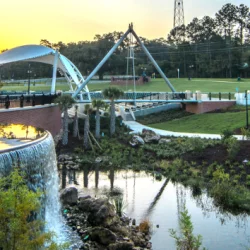Construction Industry History: From the Very Beginning to the Present-Day Building of the 21st Century
There are various types of construction today. The building sector covers different directions. For example, the major types of construction are infrastructural, industrial, commercial, and residential. But many years ago people could hardly imagine such a digital-friendly building with many peculiarities concerning the type of object to build.
Present-day contractors and subcontractors have numerous ways to perform well in the local markets. The most result-driven representatives of the construction sector try to automate almost all processes through digital-friendly approaches. For example, drones simplify measurements of the area, BIM systems make the designer’s routine tasks easier while building estimating software (https://conwize.io/) transforms the estimator’s work free from manual budget planning and costing.
But what was the very beginning of construction? The history is very long and full of important events. Let’s take a closer look at the most necessary stages of the building sector development in general.
The Beginning of the Story
It is pretty difficult to understand how exactly the history of construction precisely began. People have long tried to ensure their safety, inventing various ways. At first, these were small constructions and structural objects in the form of canopies. All tools were made from improvised means - bones, stones, sticks, etc.
What Can Be Considered the First Evidence of Construction?
Unfortunately, until our time there is almost no evidence of the historical buildings of our ancestors. However, some archaeologists and history experts believe that Olduvai Gorge, located in Tanzania, contains the remains of a hut that is about 1.8 million years old. Also, evidence of early buildings can be seen in ancient Egypt, Rome, China, Greece, and other places that have survived to this day.
Construction Evolution: All the Transformations Took Place
Over time, people began to move from villages to cities, which grew rapidly. Houses and buildings have become more complex in structure, and more adapted to modern life. Infrastructure began to develop.
To fulfill the tasks set, engineers and architects began to appear, who had to adhere to the already established rules of construction (their development began in the 16th century). These professions became independent, and specialized educational institutions appeared. Andrea Palladio and John Smeaton are considered to be the first architects of their kind.
What Was the Essence of the Industrial Revolution?
The peak of the development of the construction industry fell during the development of science in the 17-18 centuries. Thanks to this, many architects and engineers were able to experiment with new types of building materials and introduce new methods of building construction.
One of the significant changes in the early 19th century is the emergence of cast iron as the main material for building railways. At the same time, the Bessemer process emerged, making buildings and roads much faster, cheaper, and more affordable. For the same reason, Bessemer steel became the impetus for the development of skyscraper construction.
Development of Modern Construction
The entire 20th century served as the development of the construction of large-scale projects:
- The era of skyscrapers. From the beginning of the 20th century, skyscrapers began to rise at an incredible rate. New York has the largest number of them to date. The tallest and most popular of them are the Flatiron Building and the Woolworth Building. Throughout the construction of these high-rise buildings, architects and engineers have improved the workflow and made construction more efficient and less costly in all aspects.
- The housing boom in the US. In the second half of the 20th century, there was a surge in the birth rate and migration, which prompted the need for a large number of residential buildings.
- Development of infrastructure. As a consequence of the rapid construction of residential buildings and urban sprawl, the development of infrastructural buildings has become. One of the first and most significant projects on a large scale was the Interstate Highway in 1956.
Today, there are more and more large-scale projects, their number is growing daily.
The Future of the Construction Industry: What to Expect?
Today, the construction industry focuses on sustainability, reliability, and efficiency. With the introduction of technological innovations, including building estimator software, most of the problems began to be solved - efficiency is increased, the number of risks is reduced to make certain decisions based on data analysis, etc.
Most companies are already implementing network building into their workflow. This view is an opportunity to use various technologies for remote collaboration, and also promotes fast and accurate data exchange.
More to Read:
Previous Posts:




